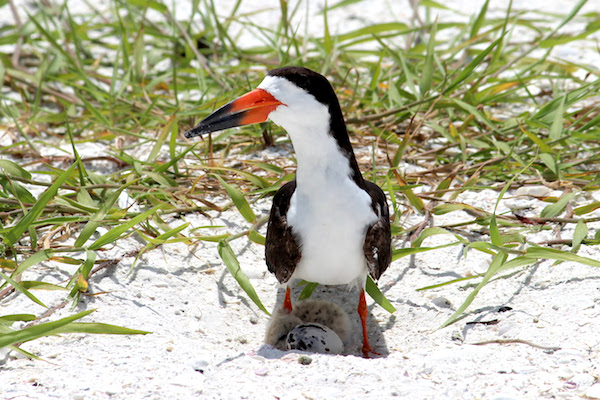SEBASTIAN – It’s nesting season for Florida’s waterbirds, and the Florida Fish and Wildlife Conservation Commission (FWC) and Audubon Florida are reminding beachgoers and boaters to give these birds and their young space to help keep them safe.
“This is a critical time of year for nesting birds and their young,” said Craig Faulhaber, avian conservation coordinator for the FWC. “By taking a few simple steps, people can enjoy a day at the beach or on the water without disturbing nesting birds and their chicks, which increases the birds’ chances of survival.”
Shorebirds and seabirds build shallow nests out of sand and shells on beaches in spring and summer, and eggs and chicks are difficult to see. Wading birds, such as herons and egrets, as well as pelicans, are also nesting now on islands around the state. Both types of birds can be easily disturbed if people approach too closely. Such disturbance can cause birds to abandon their nesting sites, exposing eggs and chicks to predators, sun exposure, and other harm.
Shorebird nests, eggs, and chicks are well-camouflaged and can easily be missed and even stepped on unless people know to look out for them. The snowy plover, least tern, black skimmer, American oystercatcher and Wilson’s plover are several of Florida’s beach-nesting bird species facing conservation challenges. Wading birds and pelicans typically nest in mangroves and on tree islands. Reddish egrets, tricolored herons, and roseate spoonbills also have experienced declines.
“Florida’s coasts took a beating from Hurricane Irma in 2017,” said Julie Wraithmell, interim executive director for Audubon Florida. “We can’t control impacts to nesting sites from weather, but we can protect them from human disturbance. This year it is more important than ever.”
The FWC has established Critical Wildlife Areas to protect congregations of one or more species of wildlife from human disturbance during critical life activities such as nesting, feeding or migration.
People can help keep nesting birds safe by keeping their distance from CWAs and other areas where birds are nesting or raising young. In addition to observing the marked-off areas around CWAs, people can also help by following a few simple steps while enjoying the beach this season:
- Keep your distance from birds, on the beach or on the water. If birds become agitated or leave their nests, you are too close. A general rule is to stay at least 300 feet from a nest. Birds calling out loudly and dive-bombing are signals for you to back off.
- Respect posted areas. Avoid posted nesting sites and use designated walkways when possible.
- Never intentionally force birds to fly or run. This causes them to use energy needed for nesting, and eggs and chicks may be left vulnerable to the sun’s heat or predators. Teach children not to chase shorebirds and seabirds, and kindly ask fellow beachgoers to do the same. Shorebirds and seabirds outside of posted areas may be feeding or resting and need to do so without disturbance.
- It is best to not take pets to the beach, but if you do, keep them leashed and avoid shorebird and seabird nesting areas. (State parks, national parks and CWAs do not allow pets.)
- Keep the beach clean and do not feed wildlife. Food scraps attract predators, such as raccoons and crows, which can prey on shorebird eggs and chicks. Litter on beaches can entangle birds and other wildlife.
- Spread the word. If you see people disturbing nesting birds, gently let them know how their actions may hurt the birds’ survival. If they continue to disturb nesting birds, report it to the FWC’s Wildlife Alert Hotline at 888-404-FWCC (3922), #FWC or *FWC on a cellphone or by texting Tip@MyFWC.com. You may also report nests that are not posted to our Wildlife Alert Program.
For more information, go to MyFWC.com/Shorebirds and download the “Share the Beach with Beach-Nesting Birds” brochure. Or go to the Florida Shorebird Alliance website at FLShorebirdAlliance.org to learn more about how to participate in shorebird and seabird conservation efforts.
For more information about Florida’s CWAs, visit MyFWC.com/CWA.
To learn how you can volunteer your time to protect nesting coastal birds, visit and scroll over the “Conservation” tab at the top, then click on “Coastal Conservation” and “Coastal Bird Stewardship,” or you may email FLConservation@Audubon.org.
